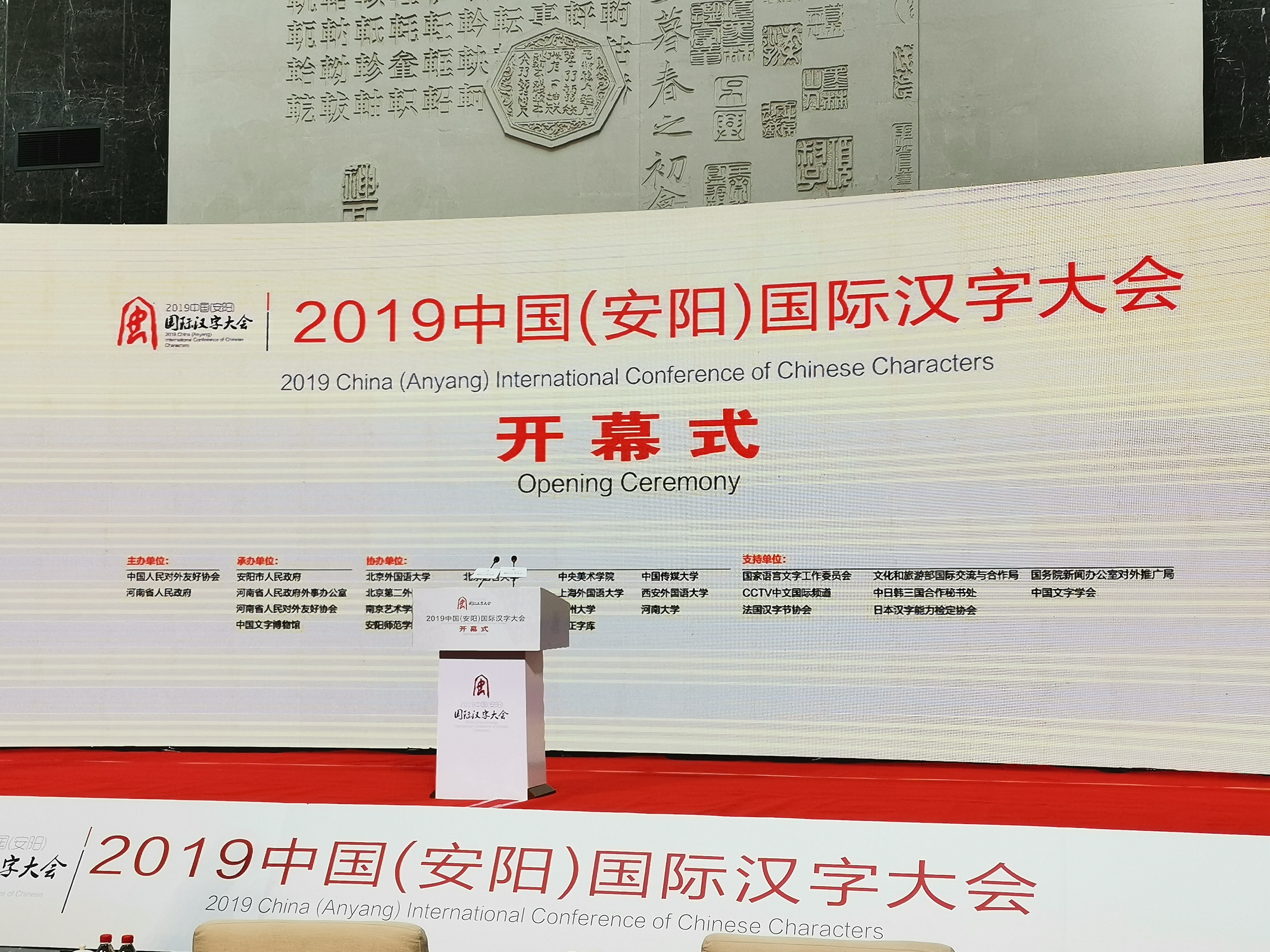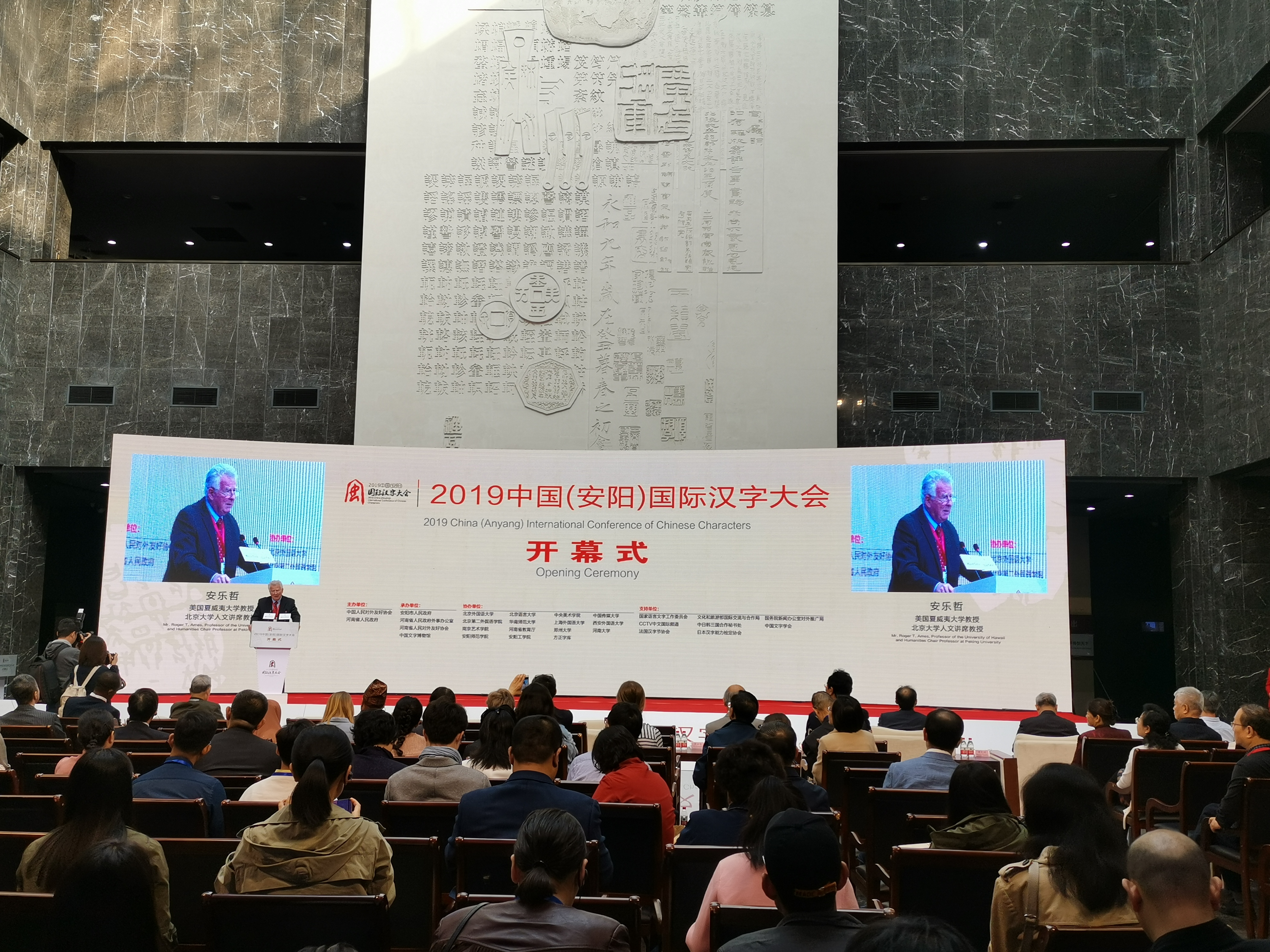

In Anyang We Are Witness the Beginning of the Hybridic Process of Tianxia to Its Continuing Influence in the Contemporary World
在安阳,见证古代人类兼容并蓄的天下观在当代世界的绵延呈现
It is a great honor to be invited to participate in a conference convened to celebrate the unrivaled role of Anyang as not only a source of traditional Chinese culture, but also the engine of this culture’s continuing importance in the modern world. I first came to Shanghai in yesterday’s mainland China in 1985 when the Peace Hotel was the tallest building. This was less than 35 years ago. We drove from Shanghai to Beijing through Shandong province, 20 kilometers at a time. There only local roads, and we had to stop and ask our way at every town. Men and women wore the same clothes. Beyond bread, garlic, and baicai, there was little for people to eat.
我被邀请参加这样一个会议,感到非常荣幸。安阳不仅是传统中国文化发祥地,也是这一伟大文化继续在现代世界发挥重要作用的引擎,安阳发挥着无以伦比的作用。我1985年第一次来到35年前中国大陆的上海,那时在上海,和平大饭店是最高的大厦。大概35年以前,我们从上海开车去北京,路过山东,速度每小时只有20公里。那时,地方只有小路,每到一个乡镇,我们必得下车问路。那时男人们和女人们穿戴没有太大差别。人们吃的东西,除了馒头、蒜头和白菜之外,没有别的。
Last month I visited the new Zhuhai campus of Zhongshan university. After arriving at the new airport, I drove for 1 ½ hours on new roads with huge building projects on either side. We passed by the new bridge that goes from Zhuhai to Macau to Hong Kong, and that is 55 kilometers long and takes a good part of an hour to drive. The month before I visited Zhangye in Gansu and the building projects are the same. The speed and the scale of what has happened to produce the new China over this past one generation is unprecedented in human history.
上个月,我去了中山大学珠海新校区。新机场下飞机后,在崭新的公路上开了一个半小时的车。公路两边是一排排高楼大厦。我们通过珠海经澳门至香港的新大桥,桥长55公里,我们的车差不多整整开了一个小时。在那一月之前,我去了甘肃张掖,公路两旁同样也是一排排高楼大厦。这只是一代人的时间,新中国发展就这个样,这个速度,这个规模,是人类历史上史无前例的。
The Yijing describes the evolution of Chinese culture in terms of change and continuity (biantong). While the change that China has seen over the past 35 years is truly remarkable, what is more remarkable yet is the irrepressible continuity of the Chinese cultural tradition reaching back into high antiquity. My good friend Zhao Tingyang at CASS has published a book entitled 惠此中国 that tries to answer the question: “Where did China come from?” Zhao Laoshi tells the story of how on the central plain of China, from earliest times down to the present day, different peoples with different customs were drawn into a centripetal whirlpool向心漩涡that made the “many” one and many at the same time. It is China’s signature story of 和而不同,of 一多不分. In his efforts to interpret China’s historicity philosophically, Zhao touches on many questions in many relevant areas of knowledge, from the discovery of the oracle bone script and China’s exciting century of archaeology in which the ancient silk and bamboo manuscripts are continuing to be recovered, to the theorizing of China’s history of thought and its sociology, politics, and economics.
《易经》对中国文化的鼎故革新说法是“通变”。短短35年之间中国的面貌变化令人注目,更令人注目的,还有中国文化传统从最古老源头高歌猛进的绵延不已。我的中国社科院好朋友赵汀阳出了一本书,书名是《惠此中国》。这本书回答的问题是“中国从哪里来”。赵老师阐述了中国中原大地从远古时代至今,不同文化的各族人民如何被吸引到一个向心漩涡中来,呈现了“多”变为“一”,同时亦是“一”变为了“多”。这是具有中国鲜明特质的“和而不同”故事和“一多不分”故事。在对中国哲学性历史的阐释之中,赵汀阳涉及到很多有关知识领域的问题。从甲骨文的发现以及中国古代丝绸和竹简不断被发掘的令人兴奋不已的考古世纪;到如今中国社会学、政治学和经济学也正在理论化过程中。
What drew these different people into the whirlpool was the cultural attractor文化吸引子of the Chinese written character. The written characters served as a sophisticated system for perpetuating a cultural corpus that, standing independent of the many spoken languages of the various peoples drawn in by it, could be read by all of them. At the Museum of Writing in Anyang in the middle of this same central plain we see on display today a vast collection of the oracle bones as the earliest extant record of this writing system. Remarkably, this Shang dynasty script already in its own time had a vocabulary of over five thousand characters, a number that exceeds the normal literacy of an educated Chinese person today.
把不同民族吸引到旋涡中来,起作用的是中国汉字——这个文化吸引子。汉字是一个使文化文献经典绵延传续的精致体系。文字独立于各不同民族的众多口头语言之外,纷纷将他们吸入旋涡,成为他们所有人的阅读语言。今天在坐落于中原大地中心的安阳文字博物馆,我们看到展示的大量甲骨文文物,皆是这个汉字体系至今尚存的最早实物。多么令人惊叹,商代字体在那么早的时代,就已经形成了五千汉字的语汇。这个数目甚至超过了今天受过教育的中国人所掌握的汉字数。
Zhao argues that this writing system was a technology of enchantment, a kind of magic, that enabled human beings to grasp the past and anticipate the future, and in so doing, transform time into their own self-awareness, self-narration, and historicity. This system established a legitimizing spiritual world the ownership of which gave political leaders the narration of an authorized history and the capacity for knowledge production that could be used to organize the hearts and minds of their people.
赵汀阳的观点是,汉字体系是一种“摄魂”魔法,可使人类捕捉历史、预想未来。人类就是这样将时间转化为自我的意识,自我的叙事与纪史。文字系统建立了一个合法化的精神世界,它赋予了政治领袖权威化的叙述历史和知识生产的能力,便于用来丰富他们人民的心灵与思想。
The written language was the powerful medium through which norms, laws, and institutions could be established, interpreted, perpetuated, and employed, and thus carried with it a determinative force that far exceeded economic influence and military prowess. Galvanizing the spiritual importance of this writing system itself was what it was what it was used to convey as the shared narration of history and the values of a common lineage. The cultural corpus perpetuated through the compilation of the canonical texts provided a growing population with an evolving, collective spiritual identity, and the development of a common cosmology through which the human experience could be organized and explained. Indeed, within this spiritual world, these classics and history were aspectually one, reinforcing and lending authority to each other. And even while during different historical epochs the center of the whirlpool would shift geographically from north to south and east to west, the continuing spiritual center was this culture of the central plain.
汉字语言是强大的媒介。有了汉字,规范、法则和组织机构得以建立,获得解释、持久长存及付以施用。并因此带来一种决定性的强大力量,它远远超过经济影响与军事实力。激活汉字系统内在精神重要性的,正是它本身,正是它作为宗系、一脉相承的价值和共同历史叙事的传承功能。通过经典文化编纂而传承的文化经典,向不断增多的民族人口提供一个苟日新日日新的共同精神认同和宇宙观。通过共同的精神观与宇宙观,人类经验得以组织和诠释。在不同历史时期,这些经典和历史,也是从方方面面汇成一体,彼此互相强化并赋予权威性。
This process of identity formation driven by a series of interrelated “cultural attractors” included as the most significant among them the written character, and then included the canonical texts that perpetuate a shared cultural identity, and the social and political narrative that grew from them. These attractors have drawn disparate populations on the central plain of China and its surrounding territories into a vortex, a whirlpool that was already taking shape more than four thousand years ago during the Xia, Shang, and Zhou dynasties, and that then continues in protean form down to the the present day. In this book, Zhao is forwarding a novel and compelling thesis on not only how we should understand China, but also until recently, how China in all of its diversity, has understood itself.
身份认同的形成过程,是由一系列相互关联的文化吸引子所驱动;这些吸引子中最具重要意义的是汉字,它被囊括于经典文献之中,使得共同的文化身份传承延续,社会和政治叙事得以产生。在中原大地及其周边土地上,这些吸引子吸引着处于水深火热的民族,并将他们吸入漩涡——一个四千多年以前在夏、商、周朝代已然形成的激流涌进的漩涡,它多姿多彩的呈现,一直延续至今。
Zhao Tingyang is a philosopher. In asking the question, “Whence China?” he begins from an ontological answer that he draws from the first among the Chinese philosophical classics, the Yijing orBook of Changes. The fundamental reason for existence itself is生生不已the unceasing process of procreation, of generation and regeneration. As the Book of Changes announces: 天地之大德曰生 “The greatest capacity of the cosmos is the production of life itself.”
赵汀阳是一位哲学家。在问:“中国从何而来?”他从一个本体答案开始,这个答案源自于群经之首的哲学经典《易经》。“生生不已”是生存本身的根本理由。正如《易经》说:“天地之大德曰生。”
Zhao appeals to the archaeological scholarship of Xu Hong 许宏whose notion of the “earliest China” (zuizai de Zhongguo 最早的中国) can serve as point of reference to establish the tentative trajectory of a universalizing, all-inclusive, and distinctively Chinese generative process of geopolitical order calledtianxia天下. The erstwhile beginnings and evolution of this conception of world order reaches back into the mists of history before the Xia, Shang, and Zhou dynasties to what prominent archaeologist Su Bingqi苏秉琦has called a “sky full of constellations” (mantianxingdo 满天星斗)—a description of the many different, independent, and unique civilizations, each with its own narrative integrity, that were spread out across the central Chinese plain and the four surrounding areas. In this earliest period,tianxia references an emerging, holistic world politics that, as an inside without an outside, is at once diverse without being fragmented by the notion of determinate and bounded nation-states. Cosmologically and religiously too as a natural theology, tianxia is a process that in its evolution, establishes a cultural center for the earth, and in so doing, sets an axis that sanctifies the human world in its veneration of tian and the earth.
赵汀阳引用许宏考古学研究的“最早的中国”观念。作为参考,建立一个“普世化”的、包罗万象的,具有明显中国特质的地缘政治秩序过程轨迹——“天下”。在此之前,关于世界秩序的起源与演化,可溯源到夏、商、周以前历史的迷雾中去,需到著名的考古学者苏秉琦那里。苏秉琦的说法是“满天星斗”——一个对众多不同、自成一体、特质性强的文明的描述。每个文明都有它自成一体的叙事,在中原大地上及其四环地域处流传。在最早时期,“天下”指的是一种新兴的、整体的世界政治——它是作为只有内在而无外在,既多样性,又不被确定的、有严格边界的“民族国家”(nation-state)的观念所分裂。在宇宙论和宗教性上,它也是一种自然神学;“天下”是一个过程,在其进化当中,建立一个大地上的文化中心,并以此为轴心,将人类世界正当化,尊其为“天和地”。
China in its original formulation is tianxia, an unbounded process of growth in world order. For Zhao, China is not a place, but a “taking place”—a world-making out of a centripetal whirlpool that over time has taken the mere “variety” of the constellations of many different cultures, and on the basis of their vital, ecological interdependence, has transformed them into a shared syncretic “diversity” in which the differences that obtain among the many different peoples have been activated to make a difference for each other. And here in Anyang, we stand at the beginning of the history of this hybridic process of tianxia, and are witness to its continuing influence in the contemporary world.
中国自其一开始,即形成“天下”观,是世界秩序的一个无限生长过程。在赵汀阳看来,中国不是一个地方,而是一个发生过程——一个从向心漩涡而出现的世界呈现(world-making);随着时间的推移,它将星罗棋布、众多不同文化的形形色色,都融化在一起,并在它们生生为贵、生态相互依存的基础上,将它们转化为一种共合曲调的“多元化”,使得众多不同民族形成的特质都被激活和调动起来,变为彼此相配的特质。今天在安阳,我们站在兼容并蓄过程的“天下”历史起点上,见证她在当代世界的延绵呈现。